Hey friends, I am here again with another episode of Simple Questions series. But first of all thank you for the overwhelming support and feedback in the previous episodes. Today, I'm going to discuss another simple question: How big is the universe? What is its shape? Is there any limit? So let's begin.
The UNIVERSE — What is it actually?
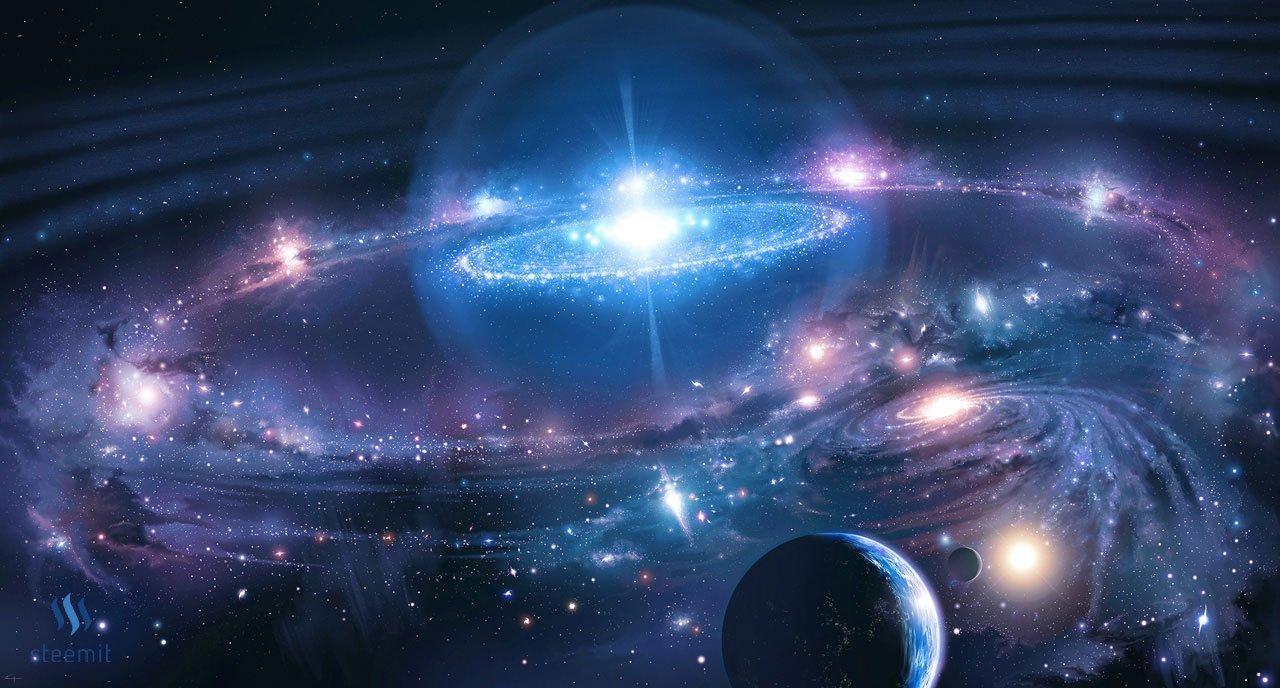
Wikipedia defines it as,
“everything that exists, everything that has existed, and everything that will exist”
The early man was mesmerized by the view of the night sky full of uncountable stars and the moon, as we see even today. But the only difference is that, at that time the early man had no idea of what that was, but today we have a little bit of idea and understanding of the things we see in the sky.
Ancient Indian philosophy [Rigveda -1500 to 1200 BC] describes the whole universe as a “cosmic-egg” or Brahmanda which goes through a cyclical process of creation, destruction and rebirth. It suggests that the whole universe or Brahmanda expands out of a single concentrated point called a Bindu before subsequently collapsing again after every 4,320,000 years. [1]
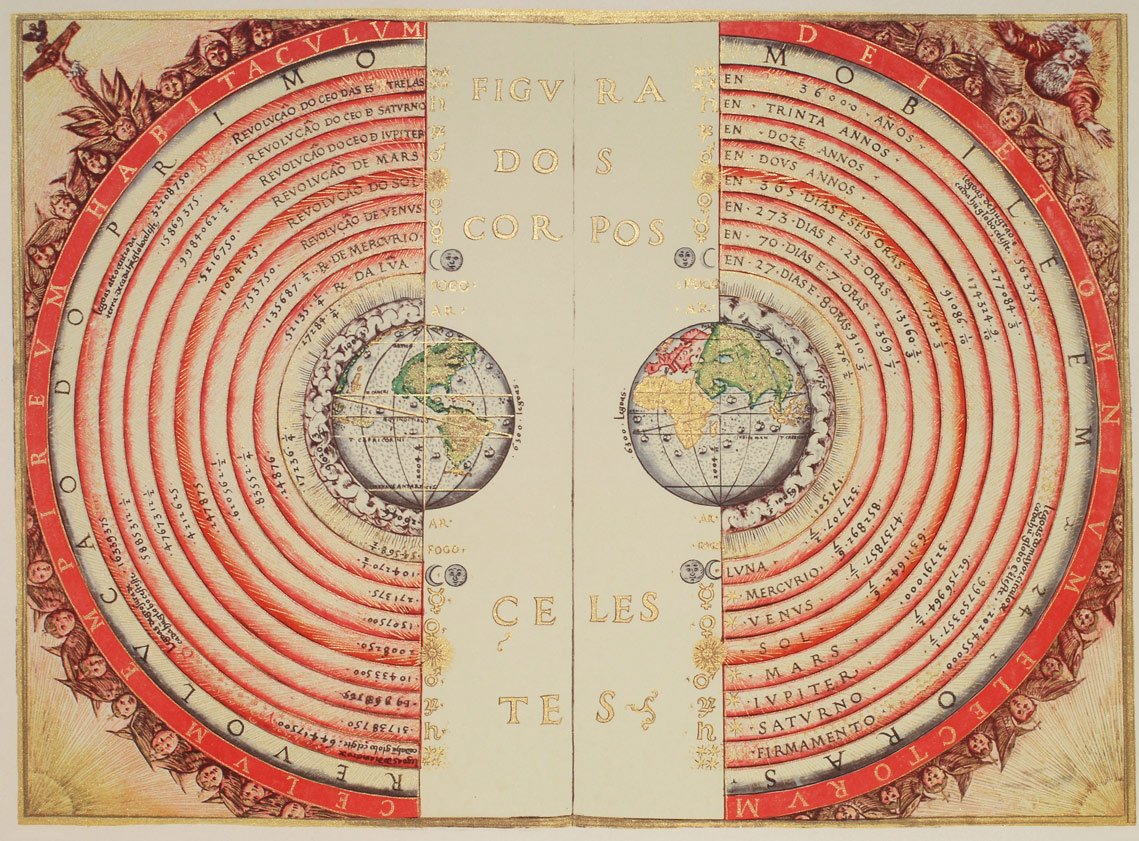
An illustration of the geocentric universe by Portuguese cosmographer Bartolomeu Velho, 1568 | Wikipedia
The Greek philosopher, Aristotle in the 4th century BC, suggested a universe with the spherical Earth at its center surrounded by all the celestial objects around it. He believed in a finite and static universe which existed since infinite time, unchanged. Aristotle also argued that the universe is made up of five elements out of which four are the previously established classical elements: Fire, Water, Air and Earth and the fifth one added by him: Aether (which fills the void of the universe). [2]
Humans are trying to decipher the secrets of this splendid universe since time immemorial. Yet we are not able to understand it completely. But the physicists are not ready to give up. As Einstein said in his book Physics and Reality (1936),
“The most incomprehensible thing about the universe is that it is comprehensible.”
This gives them motivation and different theories have been proposed about the existence and origin of the universe.
Some physicists believe in an eternal and infinite universe while others believe in an infinite universe which actually had an origin. There is yet another cult of physicists who believe in a finite universe. Different physicists have a different say about the universe.
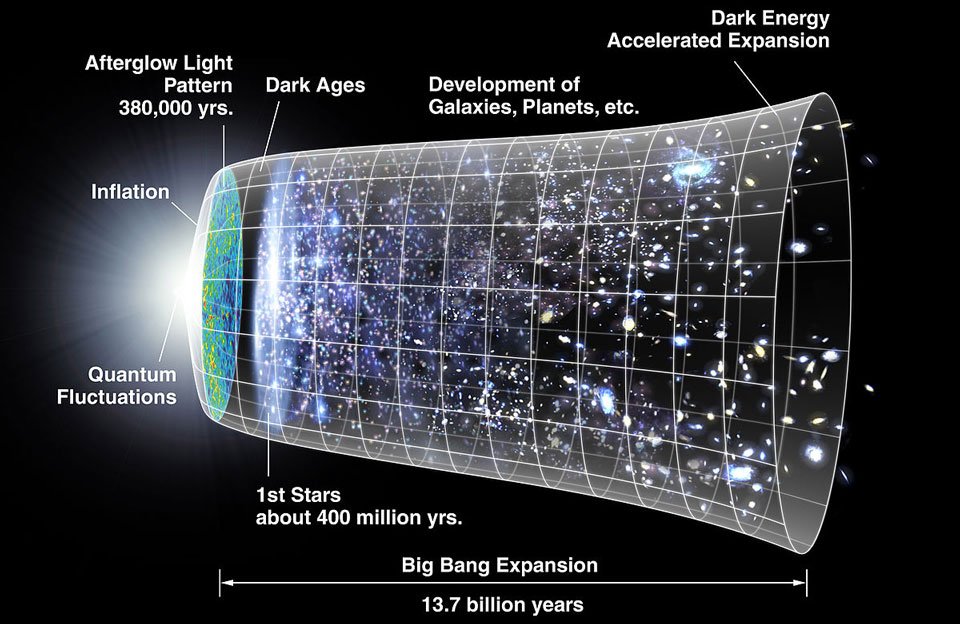
Timeline of the metric expansion of space starting from Big Bang | Wikipedia
But presently the most accepted theory is the Big Bang Theory, which supports the view that the universe is infinite (with infinite space) and yet it's expanding. If we reverse the process, we get a single point of infinite density called “the singularity”. So, it suggests that everything exploded out of a single point 13.8 billion years ago which is considered as the age of the universe. [3]
However, there are many inconsistencies in this theory also, like if anything had an origin then it must have an end, but it says that universe is infinite. Another problem is that why there is more matter than antimatter (Baryon Assymetry).
Yet there is another simpler problem: What is the shape and structure of the universe and how big is it?
Structure of the Universe
Almost everything that we see in the night sky is a part of our galaxy (Milky Way) because they are the closest (and thus brightest) objects to the Earth.
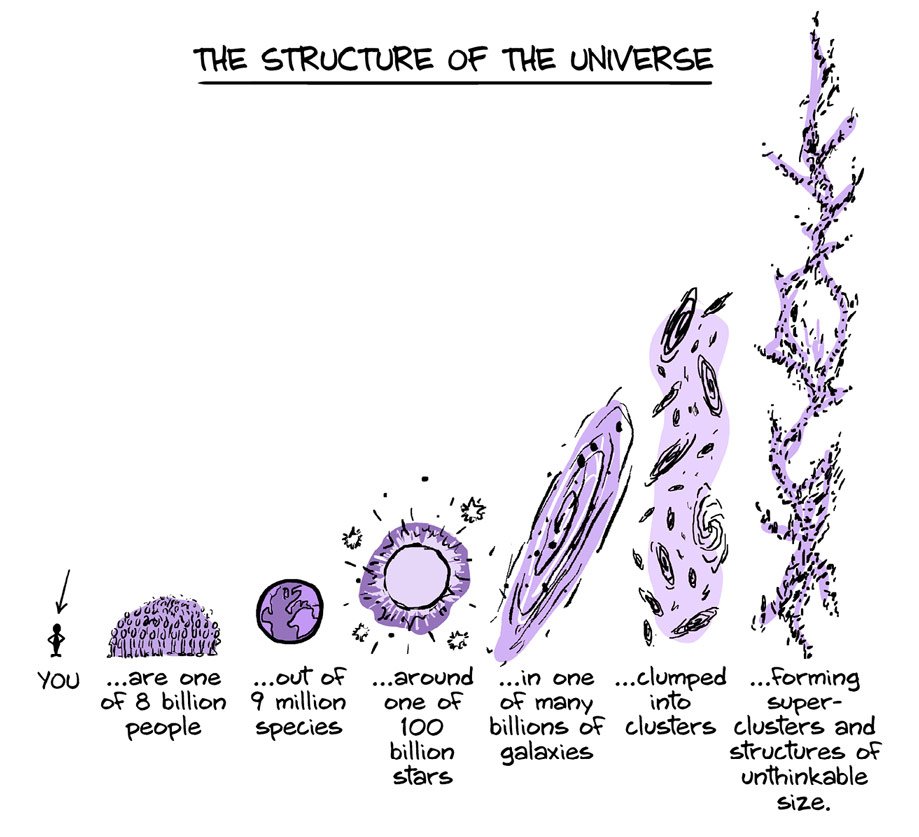
Hierarchy of the universe | Book: We Have No Idea
The universe consists of innumerable celestial bodies out of which our home, the Earth is one. This third planet of our solar system and other seven planets revolve around the Sun, as it orbits the center of our galaxy which is a huge spiral disc with several arms swirling out from a bright central hub. There are about 100 billion stars in our Galaxy out of which our Sun is one.
Our universe is mostly dotted with innumerable galaxies and there is no evidence of lone stars floating between galaxies. Previously it was believed that stars were evenly sprinkled throughout space, until we built a telescope powerful enough to observe that stars clustered together to form a galaxy. And out of those billions and billions of galaxies our Milky Way is one. So you may be feeling that how unimportant we are in this universe!
Don't hurry, there is even a bigger picture I want to show you. Just hold your seat.
The recent observations show that even the galaxies are not evenly distributed throughout the universe, they tend to clump together to form loose groups and clusters. These clusters again group together to form massive superclusters each with dozens of clusters.
As we see that the structure of the universe is very hierarchial up to the size of galactic superclusters and follows a pattern. Moons orbit planets, planets orbit stars, stars orbit the centre of their galaxies, galaxies move around the centre of their clusters, and the clusters zoom around the centre of superclusters.
The peculiar thing happens after that; superclusters don't form megaclusters or superduperclusters. But instead they do something much more surprising: they form sheets and filaments. These sheets of superclusters are impossibly vast structures, hundreds of billions of light years across, tens of billions of light years thin and infinitely long.
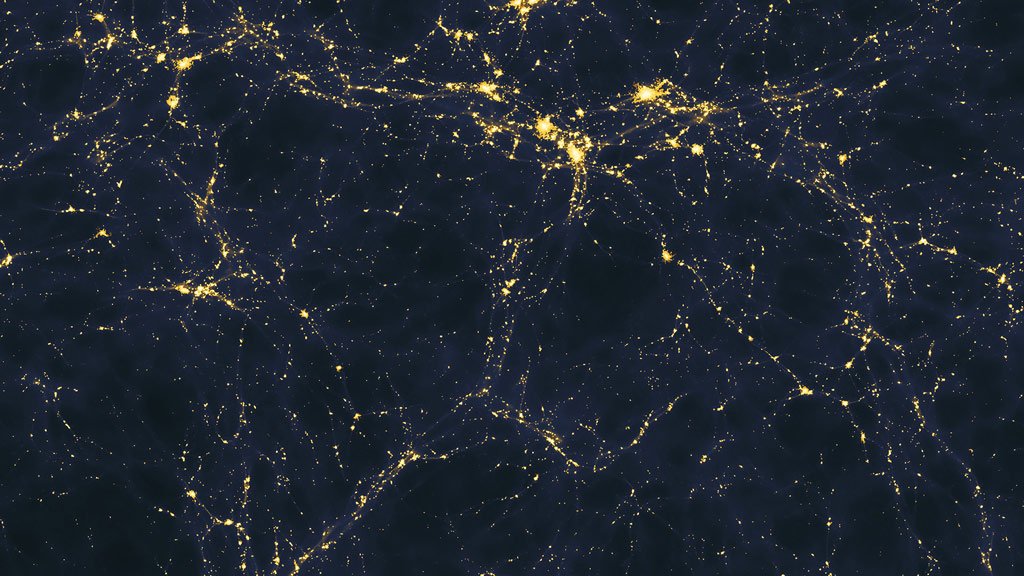
A computer-simulated image depicting large scale arbitrary structure after superclusters | PBS
The formation of superclusters is probably the largest known structure in the universe. If we continue to zoom out, we will find a repeating pattern of stars-galaxies-clusters-superclusters-sheets everywhere. But no larger scale structure is formed.
However, one thing is clear from this, now you can speculate how unimportant we are. Although it remains to find out whether it’s unusual when it comes to life and intelligence.
Now let's return to the agenda. Why do we have this structure at all? Why are stars not evenly distributed throughout the universe like dust particles floating in an old room?
If the universe were infinite and smooth, then every particle would have been equidistant from each other and would have experienced equal gravitational pull. In that case none of the particles could move in any direction and thus the universe would have been still.
And if the universe were smooth and finite then every particle would have been attracted towards the same point i.e. the center of mass of the universe. Hence they would clump together to the same point and the rest of the universe would have been empty space.
In either of the case we do not get any local group or structure of particles as we actually see in our universe. However, physicists have some nice theory explaining why we have a universe full of structure.
At the beginning, the universe was smooth and hot but had some quantum fluctuations and with the rapid expansion of space, these small fluctuations formed large wrinkles which seeded the formation of stars and galaxies with the result of gravity. And that was aided by dark matter and even dark energy made its way to start stretching out space even farther.
So in simple words, it can be said that space expanded so rapidly that gravity didn't get time to clump the particles together and thus resulted in the formation of different local structures. This may also explain why we don't have any megacluster or superdupercluster. Probably there just hasn't been enough time for gravity to pull things together to form bigger structures than superclusters.
Now you may have got some idea about the vastness of the universe. But how big is it? Is there any limit?
Size of the Universe
Even though we have lots of information about the structure of the universe but we don't know its limits. We don't know how big it is out there. Light brings us beautiful pictures of the different parts of the universe, but it had only 13.8 billion years to do it (age of the universe). Which means that anything beyond that is invisible to us. But this is not fully true, actually space itself can expand faster than light (and has done it in past), so it adds up to the size of the visible universe: 46.5 billion light years in every direction. Whatever picture we see through the telescope, we actually see the past and if we see 46.5 billion light-years we will actually be seeing the origin or the picture of the infant universe. But still we shall never be able to see what's beyond that horizon at present.

Size of the observable universe | Book: We Have No Idea
Every year an extra visibility of one light year gets added to the observable universe but in the meantime space is also expanding at a rapid pace so, probably our observable universe may never be able to catch up to the actual universe.
As we cannot actually observe the limits of the universe, anything cannot be clearly stated. However, some logical assumptions can definitely be made:
A finite Universe in infinite space

The strangeness of infinity | Book: We Have No Idea
It may be possible that the universe is finite in size but have grown so large (due to expansion of space) that we cannot observe it as a whole in infinite space.
Before the inflation the size of the universe was speed of light times the age of the universe, since space had not yet done any expansion or stretching.
Now taking into account all the stretching that took place later on and gradual expansion of space (due to dark energy) which is still going on we get a universe of unthinkable size even if it is finite.
So even if we accept the unjustified assumption that universe is finite, we still don't know how big it is.
A finite Universe in finite space
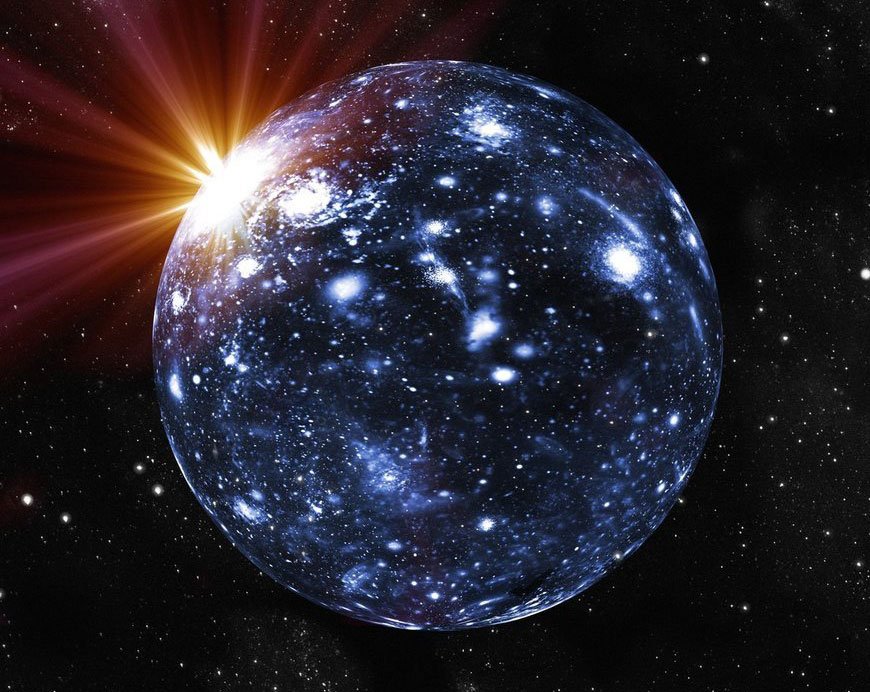
An illustration of finite spherical universe in the 4th-Dimension
A finite universe is okay, but how can we imagine a finite space. So, to assume that we first need to assume that space is curved. Which means that the universe is curved and the space is like a surface of a sphere in 4th or more dimension. In that case we'll find a finite space, just like the finite space on Earth's surface. In that situation everything would loop around in such a universe, like if you start travelling in one direction, it would eventually lead you back where you started (just like what happens on Earth).
In that mind-bending scenario, light travelling through such a universe would also loop around and might pass by Earth more than once. If that happens then we could easily observe it: we would find multiple images of same object, once for each time the light loops around. And then we might see multiple moons and stars (the same one like Pole Star) at the same time.
Unfortunately, that doesn't happen in our universe. Scientists tried hard and observed the farthest galaxies to find any evidence of that but didn't find any.
Maybe universe and space is not finite or it is so big that even light has not been able to complete its first loop.
An infinite universe
It may be totally possible that space is infinite with infinite amount of matter and energy. This is a brain-twisting possibility as the concept of infinity is itself very much strange. In an infinite universe, the possibility of anything to happen is infinite. So anything we imagine to happen maybe happening somewhere in the universe (no matter how unlikely unless the probability isn't zero). In an infinite universe, there may be a same person like you who is a billionaire. There may be a planet like Earth in which Steem is more powerful than Bitcoin. So there are infinite possibilities for anything to happen, not only once, but infinite number of times.
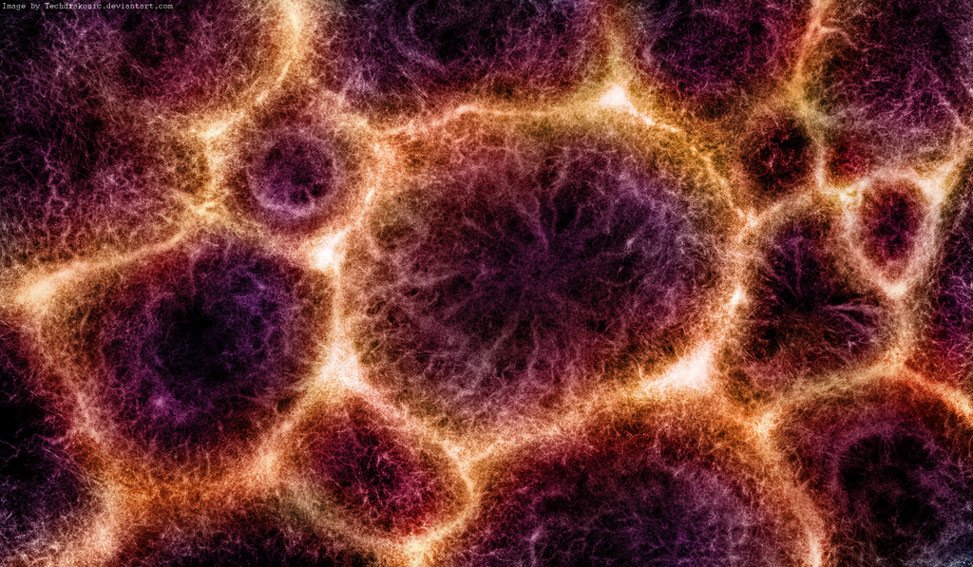
A depiction of simultaneous multiple Big Bangs by Techdrakonic | Deviant Art
But how can an infinite universe be any logical as compared to what we see? Can a universe which is infinite be expanded from a Big Bang?
Yes, but only if Big Bang happened not only at one point but everywhere at the same time.
Conclusion
So we saw that the size of the universe is really incomprehensible. But still we are trying through our observations to predict its structure and shape. We have different scenarios for the universe: finite matter in infinite space, finite matter infinite space, infinite matter in infinite space, but we really don't know which is our reality.
Physicist even tried to find the shape of the universe by calculating the curvature of space-time which depends on the density of matter throughout the universe.
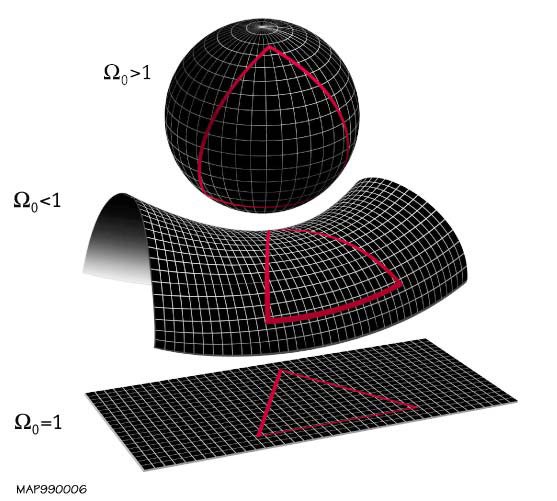
The shape of the universe is determined by whether the density parameter Ω is greater than, less than, or equal to 1 | Wikimedia
They found through the observations and geometrical calculations that universe is mostly “Flat”. [4]
Now it also supports the theory of infinite universe as we have discussed before.
But it is really strange that we have just the right amount of matter in this universe to make it flat, if we had little more matter than it would have been positively curved, and if it had a little less then it would have been negatively curved.
Whatever it may be, one thing is final, that you are a billionaire somewhere in the universe, if it is infinite!
Image Source: Pexels | Google Public Domain Images
So, which theory will you support for the Universe? Do you believe in infinite? Is there a huge cosmic whale as big as a supercluster beyond our observable universe? Do share your ideas and views through your comments. Your feedback is important for me.
References
[1] - Thompson, Richard L. (2007). The Cosmology of the Bhagavata Purana: Mysteries of the Sacred Universe
[2] - Physics of the Universe : Cosmological Theories Through History
[3] - Wikipedia : Big Bang
[4] - Wikipedia : Shape of the Universe
Bibliography - Jorge Cham and Daniel Whiteson (2017) : We Have No Idea
